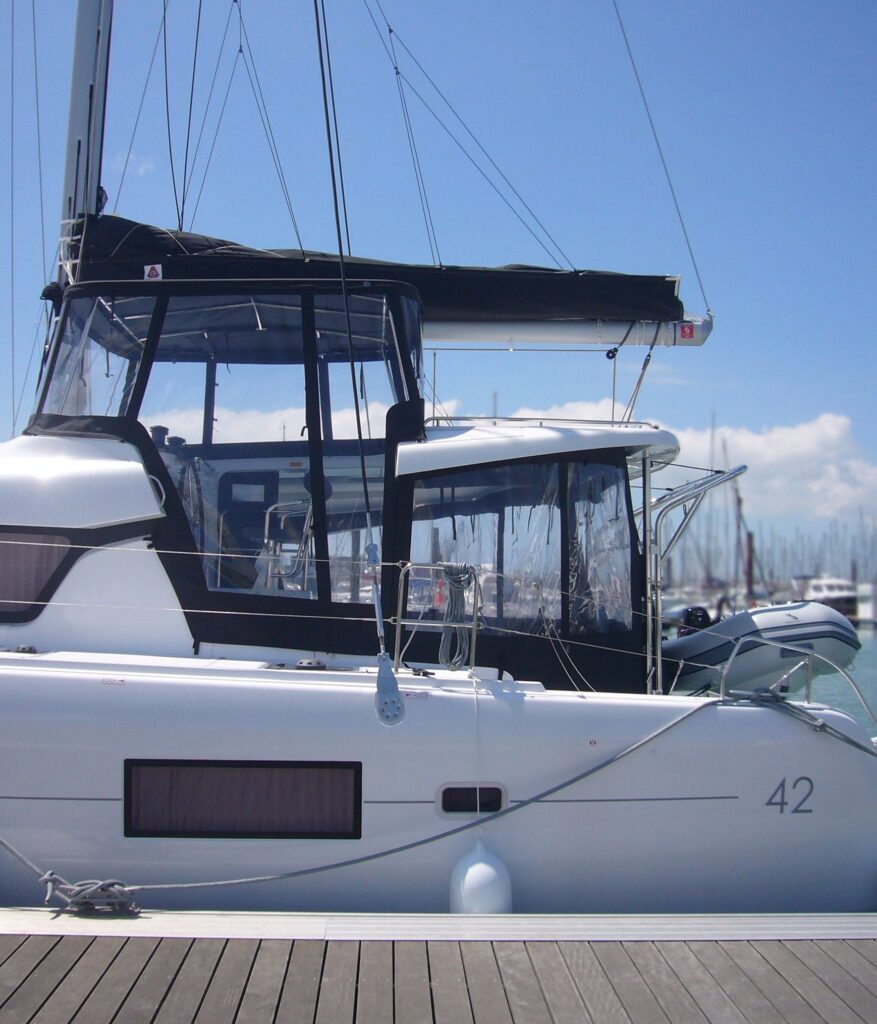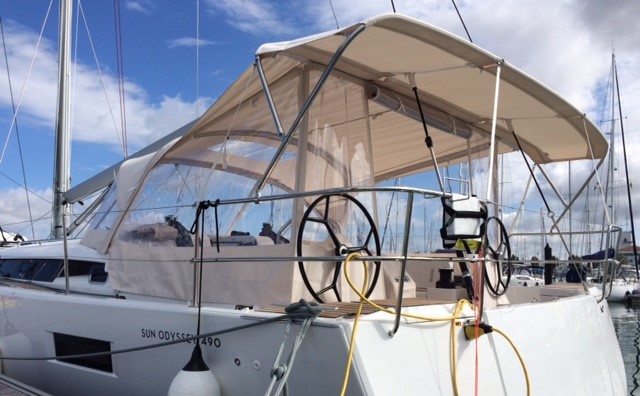
ASSEMBLY TIPS
TTOP Nautic recommends that clients have their products installed by a professional. This ensures optimal assembly and performance. Simply contact one of our dealers or the professional who sold you the product.
Proper tensioning of the products is also crucial. Make sure to regularly tighten the straps—before departure and upon arrival at the port—to prevent premature wear of certain components.
CANVAS CARE INSTRUCTIONS
Try to carry out maintenance on a monthly basis:
To keep your fabrics looking their best, rinse them with clear water each month. This stops dirt from getting deep into the material and means you won’t need to clean them vigorously too often. In most cases, a full cleaning is only needed every two to three years.
Routine or light cleaning:
- Remove dirt with a brush and rinse with a gentle water jet.
- Prepare a cleaning solution by mixing water with mild soap or liquid dish detergent.
- Clean the fabric with a soft-bristled brush, making sure the solution soaks in.
- Rinse thoroughly to remove all soap residues, and let the fabric air dry.

Intensive cleaning:
- Prepare a solution of 6 cl of bleach and 1.5 cl of mild soap per litre of clean water.
Don't forget to protect the area around your Sunbrella fabric if you use a bleach-based solution. Bleach may have adverse effects on glazing, carpets, and fabrics other than Sunbrella.
For environmental protection, when using bleach, make sure to collect the wastewater, as it can be harmful to wildlife and plant life.
- Soak the affected area for 15 minutes.
- Dab the stain with a clean sponge or towel. (Note: avoid this step when cleaning the coated side of Sunbrella Plus fabrics.)
- Rinse thoroughly to remove all soap residues and allow to air dry.

Other considerations:
- "Do not cook under your canvas (cover, bimini, etc.), as smoke, gases, and cooking vapors contain particles that can promote mold formation on the fabric.
- Ensure proper ventilation of your canvas. Insufficient airflow to remove accumulated moisture will encourage mold growth (critical threshold: over 65% humidity). Do not block side vents that allow air circulation, and never cover your canvas with a completely airtight PVC sheet.
- Do not use solvents, detergents, abrasive products, high-pressure cleaners, or washing machines to clean your fabric.
- If your fabric has minor creases, you may use an iron on the “synthetic” or “delicate” setting only. Do not use steam.
GLAZING CARE INSTRUCTIONS
Regularly remove salt and other particles using a water jet.
For stubborn marks, rinse the glazing with water before gently cleaning it with a soft cloth, high-quality microfiber, or chamois. You can use a warm water solution with mild soap if needed, then rinse thoroughly with clean water.
After cleaning, gently dry the surface with a soft cloth or sponge. Allow the glazing to dry completely before rolling or storing the material. Spots caused by residual moisture usually disappear after a few hours in dry conditions or in sunlight.
Never:
- Use detergents, solvents, or other chemicals.
- Apply waxes or automotive cleaning/polishing products.
- Use rough cloths, towels, or other abrasive materials, as they can damage the surface of the glazing


FRAME CARE INSTRUCTIONS
The canvas supports, also called 'frame,' are the structural studs of your bimini or cover. They are made of stainless steel (25 or 30 mm diameter) or aluminum (25 mm diameter).
For stainless steel, apply a stainless steel cleaning paste twice a year. Use a sponge to rub the surface thoroughly; the polishing action begins as the product dries. Repeat if necessary, then wipe the arch with a clean cloth to restore its full shine.
For aluminum, simply clean the material twice a year using a solvent-free cleaner.
PRODUCT STORAGE
To extend the life of your canvas, store your covers (hood, bimini, etc.) during the winter. Pack them carefully to avoid scratching the windows, and avoid folding in a way that could leave marks on the fabric or glazing. Before winter storage, make sure the canvas is thoroughly cleaned and completely dry (for example, when storing inside the cabin).

